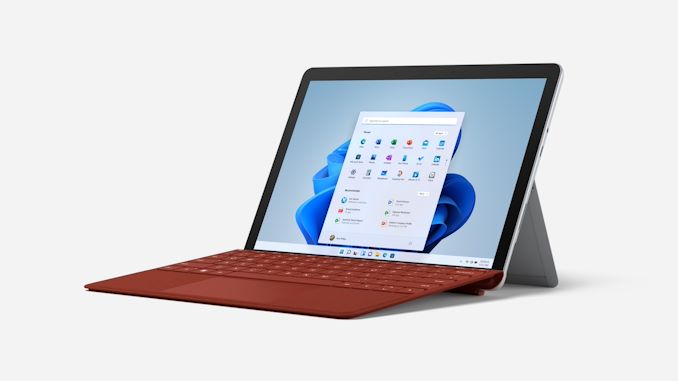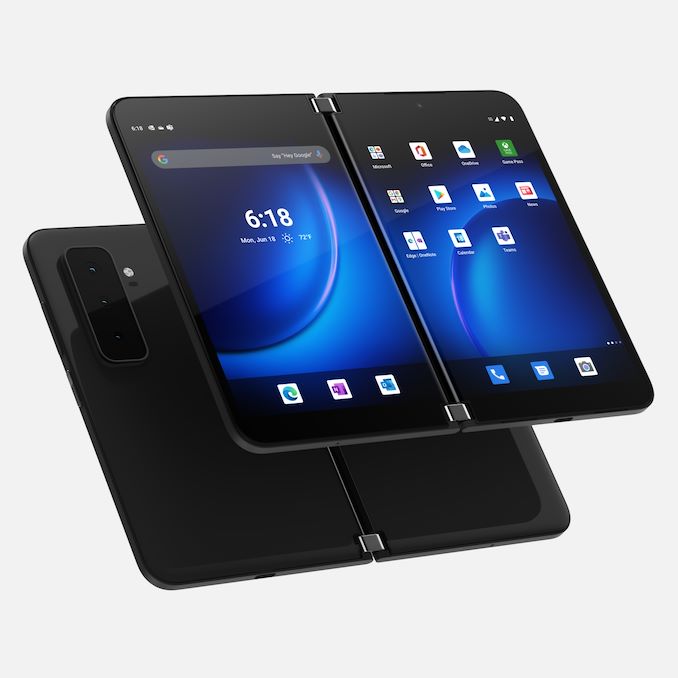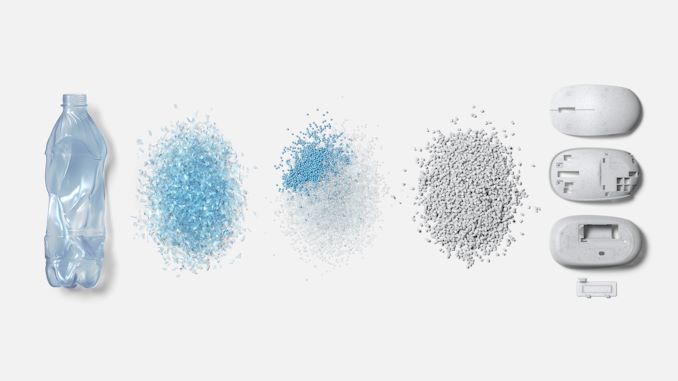Surface Laptop Studio, Surface 8 Pro Lead Microsoft's New Surface 2021 Lineup
by Brett Howse on September 22, 2021 12:00 PM ESTSurface Go 3
There is a small bump for the Surface Go line, going from version 2 to version 3. The Surface Go is the smallest, lightest, and least expensive Surface device in the lineup, but has suffered from anemic performance compared to the rest of the devices. The only significant change to the Surface Go 3 is that there is now an optional Core i3-10100Y processor, which is a higher speed bin of the venerable Amber Lake-Y dual core SoC that Microsoft used in the Surface Go 2. The base offering still comes with a Pentium dual-core, though the Pentium Gold 6500Y used here is a big step up in some ways since it can turbo to 3.4GHz, whereas the Go 2's Pentium 4425Y lacked turbo altogether.
Meanwhile the base model still ships with just 64 GB of eMMC storage, although 128 and 256 GB SSDs are available, with the latter being only on the commercial lineup. Luckily the price didn’t change, with the Surface Go 3 still starting at just $400, although that model with 4 GB of RAM and 64 GB of eMMC storage would feel awfully slow for most people.
Surface Duo 2
The second-generation Microsoft-designed folding phone is also being announced and adds performance and usability to help it compete in the high-end of the mobile phone space. Now shipping with the Qualcomm Snapdragon 888 SoC, the Surface Duo 2 adds a lot to its camera department with the inclusion of a triple-camera for wide, ultra-wide, and telephoto photos.
The folding display also gets a size bump from 5.6-inch individual screens to 5.8-inch panels, which provides an effective display size of 8.3-inches when both are opened. The Surface team also took the opportunity to add 5G support, which is also expected in 2021.
For multi-tasking, there is 8 GB of LPDDR5 memory, and storage options are 128 GB, 256 GB, or 512 GB.
The Surface Duo 2 is really supposed to showcase Microsoft’s Android app suite for Office, and with the updates, it should do a much better job considering the high-entry price of $1500.
Accessories
In addition to the devices, Microsoft is also releasing a couple of new accessories. The Microsoft Ocean Plastic Mouse is made from 20% recycled ocean plastic and is just $25.
The Surface Adaptive Kit, designed in partnership with people with disabilities, is a set of textured labels which can be attached to the keyboard and ports to make it easier to identify what they are by touch and color.
Summary
Microsoft’s Surface team has grown from just designing a couple of devices, to a wide swath of devices covering a large part of the PC market, and they have expanded beyond those borders too with the Surface Duo and Surface Duo 2. Looking at the devices holistically, the design team generally tries to offer something with a slight twist compared to the other designs on the market, and some are more successful design wins than others. The Surface Pro, as an example, as created an entire genre of devices that mimic it, and the update being announced today is a solid refresh of that design which should allow Surface Pro to continue to be the industry leader.
The Surface Laptop Studio is an interesting design, and while not a completely new concept, it looks to be a well-executed take on the convertible laptop. From the specifications, it appears to be taking over from the Surface Book, which was their previous performance-laptop. It is less complicated than the Surface Book, which should lead to an overall better product.
The Surface Pro X certainly did not see very much love, and Windows on Arm did not get advanced at all on the hardware front today. The Surface Pro 8 now gets the same 13-inch display, which is good for the Pro 8, but does diminish the Pro X. Surface Go 3 also got just the tiniest of updates and is still a somewhat awkward device. The base model is inexpensive, but unimpressive, and when the necessary options are chosen, the price creeps up. It is still a well-built device, with a wonderful magnesium allow chassis and individually calibrated display, which sounds great for $400, but the $400 model is significantly more disappointing than the upgraded models sadly.
Microsoft tends to update their hardware at almost random intervals, but quibbles aside, these updates are all welcome, with some really excellent changes, such as the addition of Thunderbolt 4. I look forward to being able to try some of these devices out in the future and see how much the changes impact the device experience.
















113 Comments
View All Comments
Tams80 - Saturday, September 25, 2021 - link
And notice how the quality of programs has decreased.There is absolutely no excuse for the likes of Discord, Teams, and Spotify to lag on most computers. Yet they do.
GeoffreyA - Sunday, September 26, 2021 - link
I haven't used any of those but agree that software does feel a bit sluggish today, despite computers getting faster. Increased use of new high-level languages, GUI frameworks, mobile being the chief target platform, etc.imaheadcase - Thursday, September 23, 2021 - link
It really i just better to get a laptop now-a-days if you want a mobile windows platform. You gain so much more than this, and the only thing you lost is..i'm trying to think..oh nothing.I literally would rather have a chromebook in the $500 range than these. That is how unappealing they are. Or even the samsung s7+ still..that was released awhile back.
damianrobertjones - Thursday, September 23, 2021 - link
You're welcome to your opinion, but the Surface Pro 7 that's sat next to me doesn't agree. I read comics off and on, play really rubbish games, use Videostudio, messing with images and more. One machine that basically does all 'I' need. Add the keyboard and dock and you have a laptop and mild desktop.Imagine that, we're all different.
P.s. Chromebooks really DO suck.
Prestissimo - Thursday, September 23, 2021 - link
Chromebooks make good laptops for browsing indeed, but Chrome OS still has years to go before maturing its Tablet UI.domboy - Thursday, September 23, 2021 - link
It's interesting to see the pricing of the Pro 8 vs the Pro X. Seems they're kind of positioning the Pro X to be the cheaper option. I don't know that I believe the "up to 16 hours" battery life claim for the Pro 8 though, the Pro 7 reportedly only got 4.5hr real-world vs the 11 hours claimed, so I won't be surprised if the Pro X continues to be the better option for longer battery life.While it is unfortunate that there is no SoC update for the Pro X, but I am glad that going forward the lack of x64 emulation will no longer be a issue.
SaolDan - Thursday, September 23, 2021 - link
I use my pro 6 all day. Big PDF drawings, controls software, wire shark and others while sending sACN over WiFi. Also there's the pro 7 plus with a bigger battery.DigitalFreak - Thursday, September 23, 2021 - link
OMFG, Surface devices finally got Thunderbolt. Guess finally enough people complained about being locked into their shitty propriety docks.DigitalFreak - Thursday, September 23, 2021 - link
Another example of shitty - AT is still running the same no-edit-button forum software from their launch in 1997.abufrejoval - Thursday, September 23, 2021 - link
I am not really going to read this article, ...on principle.Apple started the i* journey with the iPod. That was fine, it was an appliance, pretty much like a microwave.
There was zero overlap to Personal Computers aka PCs, which are very different because a) the true sovereign of a PC is the owner, b) the (general) purpose is defined by the owner.
The problem is that Apple tried to carry over their (DRM music player) appliance approach to Personal Computing.
Well it wasn't my problem, because I abandoned Apple after Jobs won over Wozniak post Apple ][.
The problem is this viral effect of the iNiverse over Personal Computing.
In my book, Microsoft is a company that sold Basic.
Ok, they also sell a Disk Operating System. The have graduated to selling a GUI, too.
Ah, and yes, they started selling Lotus 1-2-3 and Wordperfect or WordStar lookalikes, too.
But in the non-appliance, Personal Computing space, hardware, OS and applications need to be strictly separate and distinct.
Anyone overstepping these natural boundaries needs to be broken up and regulated.
M$: Please get out of hardware! And clouds! And mixing apps with an OS! And spin off gaming!
Because you are bent on reducing consumer choice, and nobody in his right mind should like or allow that.